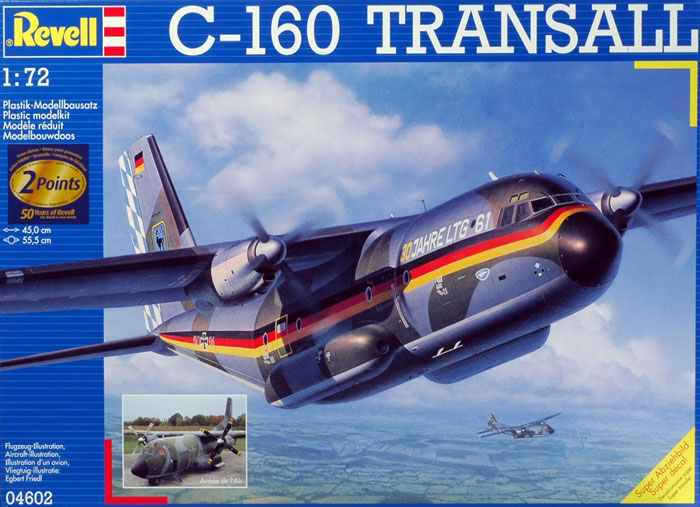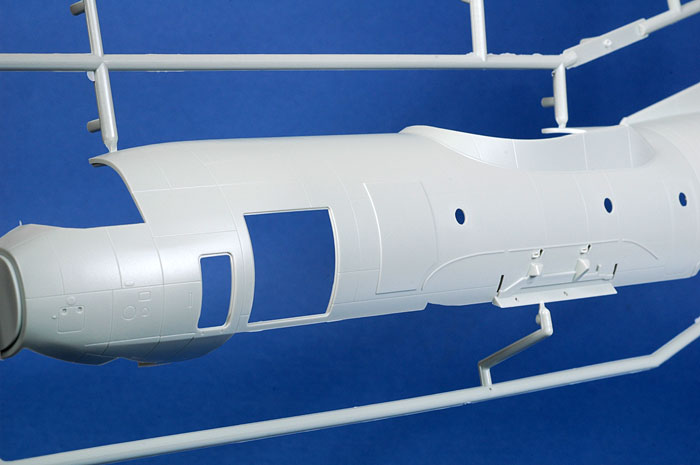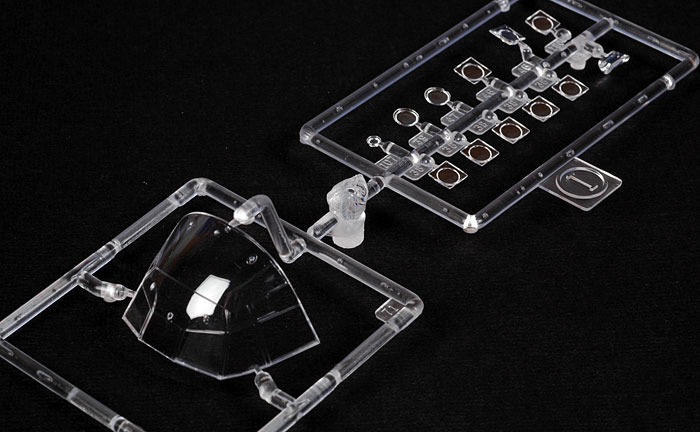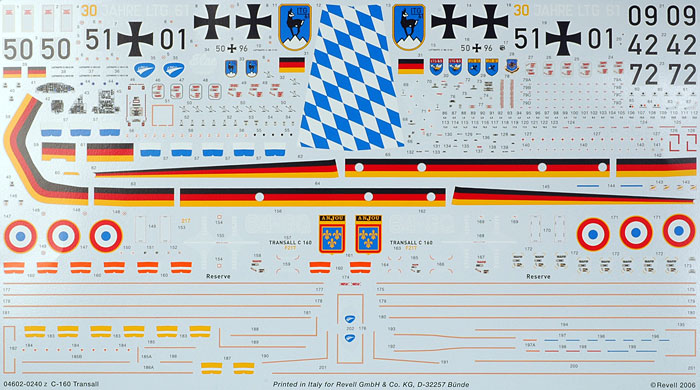|
C-160 Transall

Revell, 1/72
scale
S u m m a r y
|
|
Catalogue Number: |
Revell
04602 C-160 Transall. |
|
Scale: |
1/72 |
|
Contents and Media: |
196 light
grey plastic parts on seven sprues, 13 clear
plastic parts on two sprues, decals for 5
aircraft plus an A4 sized 20 page instruction
booklet with history, parts plan, 67 build
drawings and 3 pages of paint/decal diagrams. |
|
Price: |
£17.01 available online from Hannants and
hobby retailers worldwide |
| Review
Type: |
Preview |
|
Advantages: |
Incredible
detail including a full interior, massive decal
sheet (well printed), impressive clear parts. |
|
Disadvantages: |
It is big,
especially considering it is 1/72 scale. |
|
Recommendation: |
Highly
Recommended to 1/72 scale fans who like their
models big! |
Reviewed by Glen Porter

Revell's 1/72 scale C-160 will be available online
from Squadron.com
Over the last couple of years, Revell of Germany has
produced some very impressive large 1/72 scale kits. This
batch of big plastic
started with the He 177 Greif, BV 222, and the
latest in the line are the C-160 Transall and the brand new Fw 200
Condor. These sizeable aircraft kits in 1/72 scale have set new
standards in mould quality, buildability but, most
importantly, interior detail. The C-160 Transall is no
exception.
This has got to be the most intricate models I've ever seen.
I don't mean it is going to be hard to build, it's just
that there is so much of it. Usually, you can look at the
instructions to quickly see how a model is put together, but not in this case. The
modeller should study the instructions very carefully in
advance of building,
making sure he or she has the right parts and test fit
everything, not because of bad fit, but just to be sure the
right bits are involved. Slow and easy will be the watch
words and I think it will go together okay. I'll give you an
example. In the cockpit, there are four seats. Each has
three parts and some are slightly different to the others.
Then there are two two piece control columns, a three piece
instrument panel, floor and rear bulkhead. Each part has
plenty of moulded on detail. Then you are going to have to
work out which parts you want to paint before assembly and
which after. As I said, slow and easy and keep those
instructions handy just in case.

Click the
thumbnails below to view larger images:
The whole model is like that all the way through. The
main troop/cargo carrying area is constructed within a
cylinder which then goes inside the fuselage and it is chock
full of stretchers, troop seats with belts, some folded up
and other's down and everything highly detailed.
You then have the option of the rear and side cargo doors
and starboard crew door open or closed so in fact you will
be able to see all of this interior detail. The
undercarriage bays are as detailed as the fuselage interior
and of course you also have the option of it retracted or
deployed.
Wings and engines are pretty much standard for a 1/72 scale
kit with no interior, thank goodness.
Transparent parts are very thin and crystal clear.

Then there is the decal sheet. Struth, (Aussie slang for
“It's the truth”), you wanna see the size of this thing!
It's about 18”X 10” (46cmX26cm) and with marking for five
Transalls, four German and one French, there are literally
hundreds of them. Big and small, it's a veritable decaler's
Paradise.

I must admit, just opening the box and looking at the
contents will be a bit intimidating for many modellers.
However, if you take your time, consult the instructions
regularly, there should not be anything to trip you up and
you just might end up with a magnificent model of one of the
best looking transport aircraft ever built.
Highly Recommended.
Thanks to Revell for the sample.
Review and Text Copyright © 2006 by Glen
Porter
Page Created 28 December, 2006
Last updated 21 February, 2007
Back to HyperScale Main Page
|
Home | What's
New | Features
| Gallery |
Reviews | Reference
| Forum
| Search